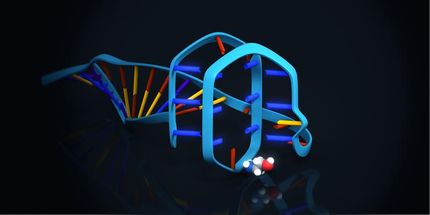Telltale Swelling
Soft microlenses as biosensors: change in focal distance signals presence of analyte molecules
Advertisement
In the future, microscale gel lenses could play a role as biosensors for analysis and diagnostics. Researchers at the Georgia Institute of Technology have developed microlenses that react by changing their focal distance when a target substance is present.
Gels consist of a three-dimensional cross-linked matrix into which a liquid is incorporated-like water in a hydrogel, for example. The team headed by L. Andrew Lyon produced tiny particles of an acrylic polymer that are deposited onto a suitable support as hemispherical hydrogel lenses. As a sample analyte for the microlenses to "recognize", the researchers chose biotin, a small vitamin. So that the lenses would later react to biocytin (a water-soluble variant of biotin), Lyon and his co-workers proceeded as follows: In the first step, they attached biotin molecules to the surface of the lenses and also generated special, reactive "anchor sites". In the second step, these prepared lenses were treated with biotin antibodies, which bind to the biotin molecules on the surface of the lens. In the third step, the lenses were irradiated with UV light. This leads to a strong bond between the bound antibodies and the anchor sites. This double binding of the antibodies results in stronger cross-linking of the gel matrix on the surface of the lens, which causes the gel to absorb less water, so it shrinks. The curvature of the lens changes as does the focal distance, which can be measured. The lens is now switched "on". If a biocytin-containing sample comes into contact with such a lens, the biocytin forces the biotin that is anchored to the lens surface out of its binding sites on the antibodies and binds to them itself. The extra cross-linking of the matrix is removed, allowing the lens to take up water and swell. The curvature and focal distance return to their original states-the lens is now switched "off". "In this biosensor system, the microlens simultaneously takes on the roles of antibody carrier, signal converter, and amplifier," explains Lyon.
The sensitivity of the lenses can be controlled by changing the number of antibodies bound to the surface. Using an array of microlenses with differing sensitivities on one chip opens up possibilities for quantitative analysis.
Original publication: L. A. Lyon et al.; "Label-Free Biosensing with Hydrogel Microlenses"; Angewandte Chemie International Edition 2006, 45, 1446.
Other news from the department science
Most read news
More news from our other portals
See the theme worlds for related content
Topic world Sensor technology
Sensor technology has revolutionized the chemical industry by providing accurate, timely and reliable data across a wide range of processes. From monitoring critical parameters in production lines to early detection of potential malfunctions or hazards, sensors are the silent sentinels that ensure quality, efficiency and safety.

Topic world Sensor technology
Sensor technology has revolutionized the chemical industry by providing accurate, timely and reliable data across a wide range of processes. From monitoring critical parameters in production lines to early detection of potential malfunctions or hazards, sensors are the silent sentinels that ensure quality, efficiency and safety.
































































